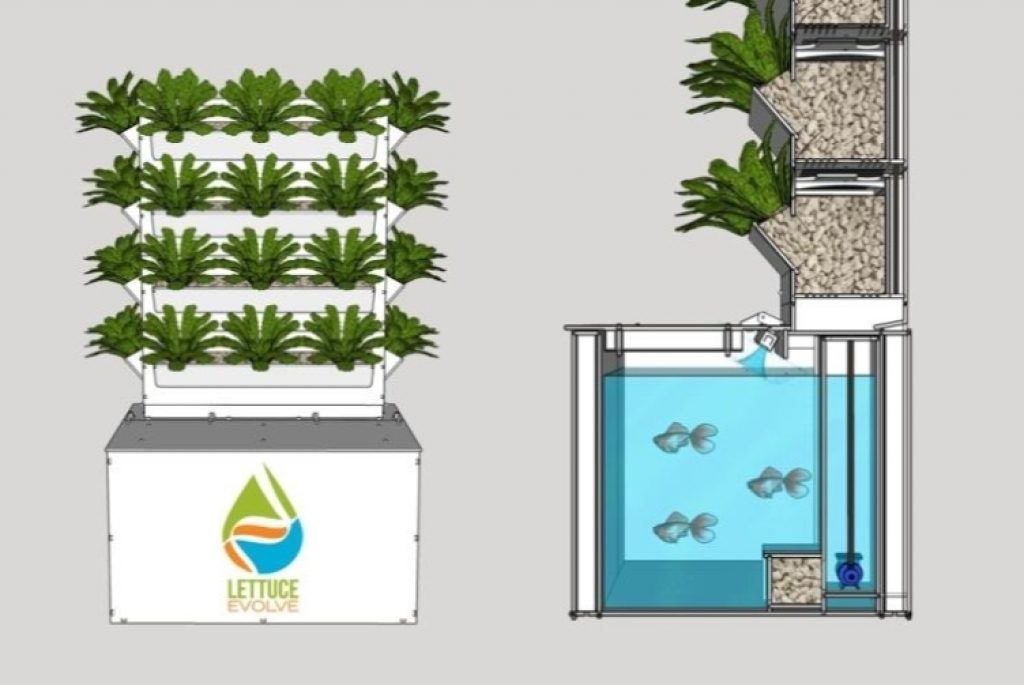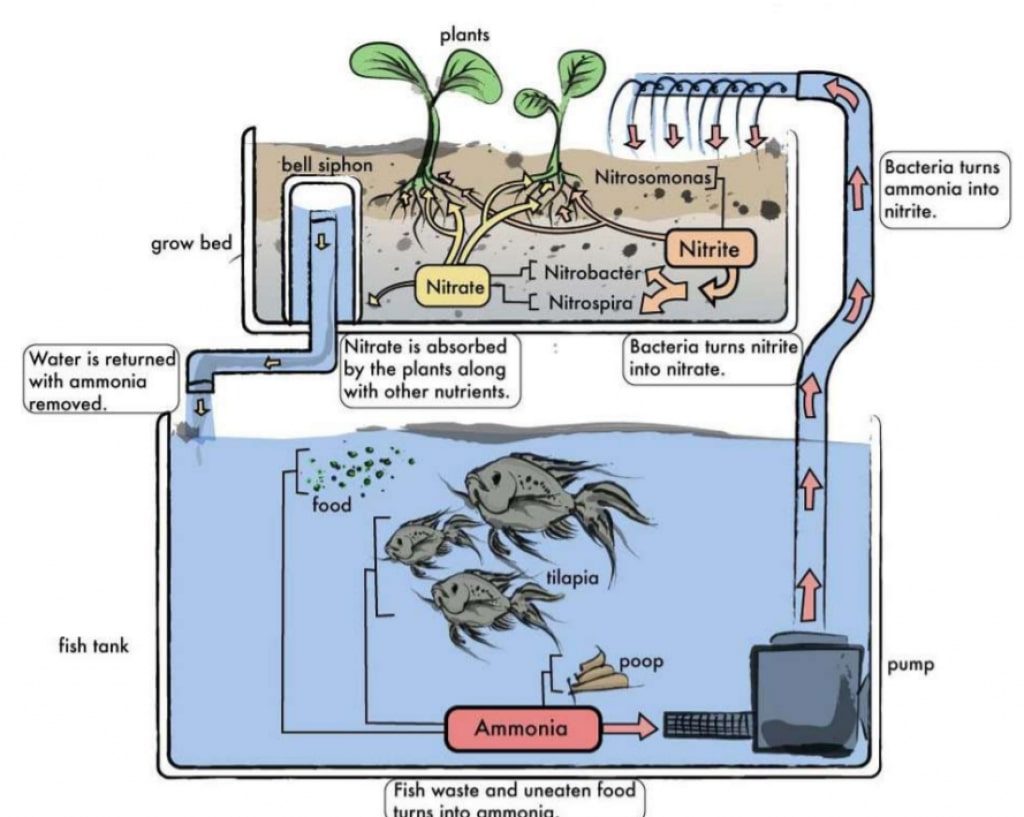Interested in gardening and aquaculture? Have limited space to do so? Well, we might just have what you are looking for — vertical aquaponic gardening!
Vertical aquaponic gardening is defined as an approach to plant growth together with fish in a re-circulating system, where plants are growing upwards. The cycling of nutrients and purification of water provides a win-win situation for flora and fauna existing together.
This type of aquaponic gardening opens doors to environmentally friendly, cost-effective techniques.
No chemicals, no waste, and better use of space!
Follow us as we explore how aquaculture and gardening come together as one!
Table of Contents
What Is Vertical Aquaponic Gardening?
Before we delve into the depths of this gardening technique, let’s familiarize ourselves with the following three concepts:
- Hydroponics – where plants and vegetables are grown without a medium such as soil.
- Aquaponics – where plants and vegetables are grown without a medium and together in a closed system with fish.
- Vertical gardening – where plants and vegetables are grown upwards.
So what is vertical aquaponic gardening then? And why is this recent technology making such a splash?
Put briefly — vertical aquaponic gardening combines aquaponics and vertical gardening. In other words, gardening upwards in an enclosed re-circulating system with fish.

Source: Garden Culture Magazine
From a scientific point of view, this gardening system is primarily based on the nitrogen cycle — where ammonia is broken down by bacteria and becomes nitrates.
How Does Vertical Aquaponic Gardening Work?
Time to get down to the nitty-gritty of this gardening technique!
The fundamental workings of a vertical aquaponic garden begin with cycling nutrients and water between fish and flora.
Waste produced from fish (yes, fish poop) flows through filers where it becomes nitrite and then converts to nitrate. The plants in the above garden absorb the nitrate-filled water and return it as purified water. The purified water goes back to the fish tank below, and the process starts again!

Source: University of Greenwich
Inner Workings
Taking a peek at the inside of an aquaponic unit uncovers the following components and processes in a cyclic manner:
| Component/Process | Function |
|---|---|
| Mechanical filter | Takes in solid fish waste and removes it from the water |
| Biofilter (Nitrification Process) | Removes waste materials that are already dissolved in the water. This includes bacteria that convert ammonia into nitrates, making for great plant food! |
| Absorption | The water with nitrates flows up to the plant, where their roots take up the water and return purified water to the tank. |
What makes aquaponics different is that the waste from aquaculture goes to plant mediums instead of the environment.
This results in the flora receiving chemical-free nutrients in a more cost-effective manner.
Vertical Aquaponic Gardening Bed Types
There are several types of vertical aquaponic plant bed setups. These may include:
Floating Raft Systems
Also known as deep water culture systems.
These setups use a specialized type of foam that floats on top of the water. Roots of growing plants draw nutrients directly from circulating water for growth.
Gravels or Media Systems
Using pebbles or gravel on top of the fish tank; this setup allows water to flow through the media. Plants would then draw water from the media and absorb nutrients for growth.
This idea may be a bit too rocky, as it limits the size of vertical garden designs.
Nutrient Film Techniques
Nutrient Film Techniques (or NFTs) are the best bed setups for vertical gardening and plants that aren’t dependent on a lot of growth support.
Adaptable for walls and ceilings, NFTs work by allowing plant roots to hang into the water freely. This contact allows for sufficient nutrient uptake.
Sounds like an ideal gardening bed!
Now that we’ve tackled the fundamentals let’s explore the pros and cons of this gardening technique.
Associated Pros & Cons
Using this technique for gardening has numerous pluses, but it also brings about a few downsides.
Information Too Important To Skip
Understanding how a vertical aquaponic gardening system works is one thing, but truly understanding the processes are a whole new ball game.
When considering entering the void of aquaponics and gardening – make sure to read up as much about plant and fish breeding as possible.
Becoming knowledgeable in putting together a fish tank is vital for safe fishkeeping practices. In the same breath, becoming knowledgeable in safe plant-keeping practices is as important.
Why are safe practices so important?
Well, if you think about it, you probably aren’t the only one in contact with your setup. Others in your household, including those with four paws, maybe around too. Moreover, the surrounding environment is essential to protect when trying out any new technology.
Safe practice is an effective way of avoiding accidents as you’re learning to master your new craft!
As the saying goes -—Know safety, no injury. No safety, know injury.
Moving on to a lighter note, can we successfully perform vertical aquaponics indoors? Read on to find out!
Can You Do Vertical Aquaponic Gardening Indoors?
So, you may be thinking of going large scale (producing food to sell) or on a slightly smaller scale (vertical gardening as a hobby).
However you plan to proceed, you may be wondering if you can set up a vertical aquaponic garden indoors?
In short — yes!

Source: Eartheasy Guides & Articles
Although the combination of vertical gardening and aquaponics is in its infancy – it certainly is possible!
Indoor aquaponic vertical gardening systems can be set up in different layouts and require different lighting (depending on the plants you choose to use). In fact, if you’re aiming towards an earth home — this system is ideal for you!
Stacked Horizontal Beds
In this design, the garden beds are stacked into a shelving layout.
This design is great because it offers the benefit of stacking plants as high as your room allows, but pumping the nutrients throughout the shared circulating system will need plenty of energy!
Keep this information in mind when considering your energy consumption.
Stepped Tier Systems
A stepped tier system is designed to where plant troughs are either fixed or can rotate.
An advantage of having this system is that light can be alternated, and nutrient flow uses less energy.
Vertical Tower Systems
Most popularly chosen – vertical tower systems!
Vertical tower systems are designed as containers or stacked modules that grow upwards.
This system allows more plants to be grown and has great existing setups, such as ZipGrows.
Which Fish Are Best For Vertical Aquaponic Gardening?
So, we’ve addressed what occurs up top. But what about the creatures down below?
There are a few key aspects to look at when choosing fish for your vertical aquaponics garden.
First and foremost, it is essential to match the breed of fish with plant species in terms of needs as closely as possible.
What exactly do we mean by this?
Both the fish and plants have temperature requirements, pH requirements, space needs, and a range of lighting requirements. Matching these requirements will result in a better chance of survival and better functioning for both fish and plants!
In other words, it’s all about balance!
Reaching deeper into the needs above and below, a thorough understanding of the flora and fauna world is essential. For example, reading up on common pests or problems among plants and fish is knowledge nothing short of crucial for success.

Source: Planted Well
Other crucial aspects to keep in mind:
- Affordability (what setup is most suited to your budget?)
- Availability (is there an availability of equipment and fish in your area?)
- Other factors unique to your system and environment (such as maintenance or installation costs)
A great idea would be to hop online and check out what stores are closest to you – the best information comes from those in the industry!
Final Thoughts
If one thing proves true about vertical aquaponic systems, it is that you have numerous options at your fingertips!
Vertical aquaponics offers a fantastic way to combine your hobbies (gardening and breeding fish), provide an aesthetically pleasing environment, or pave a path to becoming self-sufficient.
Keep an eye on your budget (for the present and future), as well as what may be best suited to your environment. Do this, and you’ll have the perfect recipe to start shopping around and getting those green fingers going.

